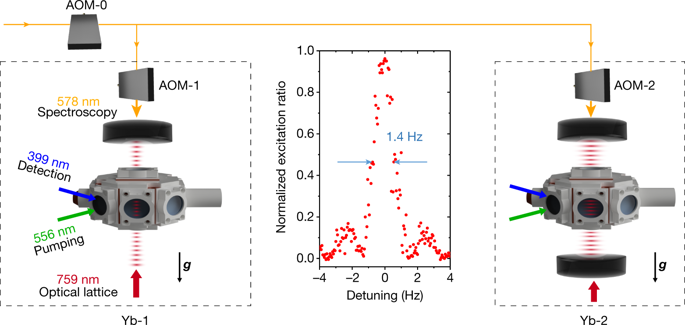Our official English website, www.x-mol.net, welcomes your
feedback! (Note: you will need to create a separate account there.)
Atomic clock performance enabling geodesy below the centimetre level
Nature ( IF 50.5 ) Pub Date : 2018-11-28 , DOI: 10.1038/s41586-018-0738-2 W. F. McGrew , X. Zhang , R. J. Fasano , S. A. Schäffer , K. Beloy , D. Nicolodi , R. C. Brown , N. Hinkley , G. Milani , M. Schioppo , T. H. Yoon , A. D. Ludlow
Nature ( IF 50.5 ) Pub Date : 2018-11-28 , DOI: 10.1038/s41586-018-0738-2 W. F. McGrew , X. Zhang , R. J. Fasano , S. A. Schäffer , K. Beloy , D. Nicolodi , R. C. Brown , N. Hinkley , G. Milani , M. Schioppo , T. H. Yoon , A. D. Ludlow

|
The passage of time is tracked by counting oscillations of a frequency reference, such as Earth’s revolutions or swings of a pendulum. By referencing atomic transitions, frequency (and thus time) can be measured more precisely than any other physical quantity, with the current generation of optical atomic clocks reporting fractional performance below the 10−17 level1–5. However, the theory of relativity prescribes that the passage of time is not absolute, but is affected by an observer’s reference frame. Consequently, clock measurements exhibit sensitivity to relative velocity, acceleration and gravity potential. Here we demonstrate local optical clock measurements that surpass the current ability to account for the gravitational distortion of space-time across the surface of Earth. In two independent ytterbium optical lattice clocks, we demonstrate unprecedented values of three fundamental benchmarks of clock performance. In units of the clock frequency, we report systematic uncertainty of 1.4 × 10−18, measurement instability of 3.2 × 10−19 and reproducibility characterized by ten blinded frequency comparisons, yielding a frequency difference of [−7 ± (5)stat ± (8)sys] × 10−19, where ‘stat’ and ‘sys’ indicate statistical and systematic uncertainty, respectively. Although sensitivity to differences in gravity potential could degrade the performance of the clocks as terrestrial standards of time, this same sensitivity can be used as a very sensitive probe of geopotential5–9. Near the surface of Earth, clock comparisons at the 1 × 10−18 level provide a resolution of one centimetre along the direction of gravity, so the performance of these clocks should enable geodesy beyond the state-of-the-art level. These optical clocks could further be used to explore geophysical phenomena10, detect gravitational waves11, test general relativity12 and search for dark matter13–17.Improved techniques allow the measurement of a frequency difference with an uncertainty of the order of 10–19 between two independent atomic optical lattice clocks, suggesting that they may be able to improve state-of-the-art geodetic techniques.
中文翻译:

原子钟性能可实现厘米级以下的大地测量
时间的流逝是通过计算频率参考的振荡来跟踪的,例如地球的自转或钟摆的摆动。通过参考原子跃迁,可以比任何其他物理量更精确地测量频率(以及时间),当前一代光学原子钟报告的分数性能低于 10-17 级 1-5。然而,相对论规定时间的流逝不是绝对的,而是受观察者参考系的影响。因此,时钟测量表现出对相对速度、加速度和重力势能的敏感性。在这里,我们展示了本地光学时钟测量,其超越了当前解释地球表面时空引力失真的能力。在两个独立的镱光晶格钟中,我们展示了三个基本时钟性能基准的前所未有的价值。以时钟频率为单位,我们报告了 1.4 × 10−18 的系统不确定性、3.2 × 10−19 的测量不稳定性和以十次盲频率比较为特征的再现性,产生了 [−7 ± (5)stat ± ( 8)sys] × 10−19,其中“stat”和“sys”分别表示统计和系统不确定性。尽管对重力势差的敏感性可能会降低时钟作为地球时间标准的性能,但同样的敏感性可以用作非常灵敏的地势探测 5-9。在地球表面附近,1 × 10−18 级的时钟比较提供了沿重力方向一厘米的分辨率,因此,这些时钟的性能应该能够使大地测量超越最先进的水平。这些光学钟可以进一步用于探索地球物理现象 10、探测引力波 11、测试广义相对论 12 和搜索暗物质 13-17。改进的技术允许测量两个独立原子之间不确定度为 10-19 的频率差。光学晶格钟,表明它们可能能够改进最先进的大地测量技术。
更新日期:2018-11-28
中文翻译:

原子钟性能可实现厘米级以下的大地测量
时间的流逝是通过计算频率参考的振荡来跟踪的,例如地球的自转或钟摆的摆动。通过参考原子跃迁,可以比任何其他物理量更精确地测量频率(以及时间),当前一代光学原子钟报告的分数性能低于 10-17 级 1-5。然而,相对论规定时间的流逝不是绝对的,而是受观察者参考系的影响。因此,时钟测量表现出对相对速度、加速度和重力势能的敏感性。在这里,我们展示了本地光学时钟测量,其超越了当前解释地球表面时空引力失真的能力。在两个独立的镱光晶格钟中,我们展示了三个基本时钟性能基准的前所未有的价值。以时钟频率为单位,我们报告了 1.4 × 10−18 的系统不确定性、3.2 × 10−19 的测量不稳定性和以十次盲频率比较为特征的再现性,产生了 [−7 ± (5)stat ± ( 8)sys] × 10−19,其中“stat”和“sys”分别表示统计和系统不确定性。尽管对重力势差的敏感性可能会降低时钟作为地球时间标准的性能,但同样的敏感性可以用作非常灵敏的地势探测 5-9。在地球表面附近,1 × 10−18 级的时钟比较提供了沿重力方向一厘米的分辨率,因此,这些时钟的性能应该能够使大地测量超越最先进的水平。这些光学钟可以进一步用于探索地球物理现象 10、探测引力波 11、测试广义相对论 12 和搜索暗物质 13-17。改进的技术允许测量两个独立原子之间不确定度为 10-19 的频率差。光学晶格钟,表明它们可能能够改进最先进的大地测量技术。











































 京公网安备 11010802027423号
京公网安备 11010802027423号